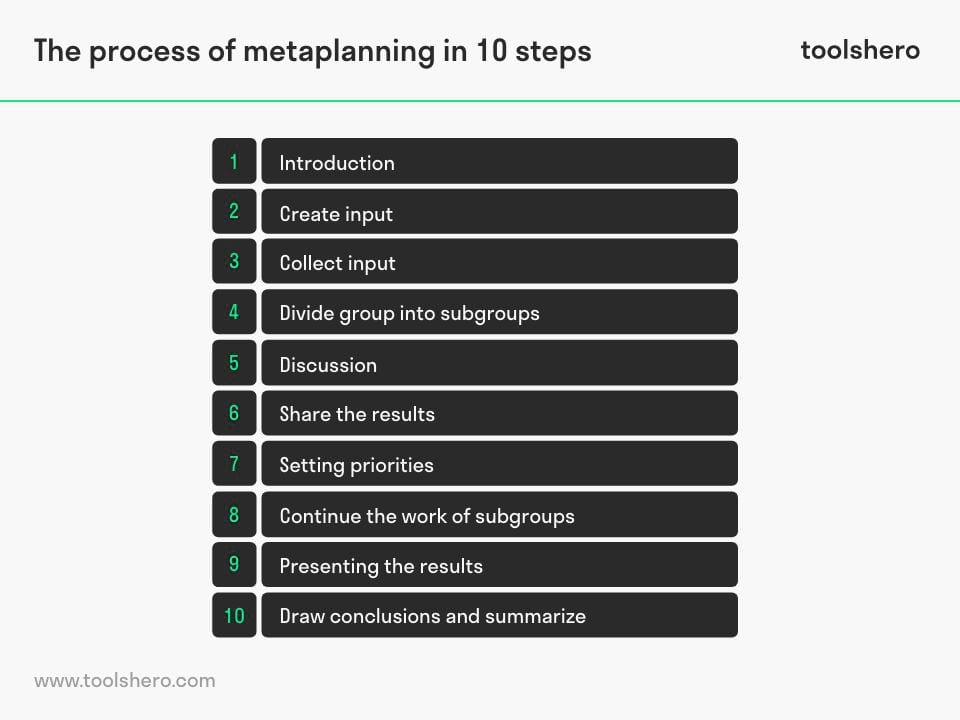Meta Planning Technique and Process

Meta Planning Technique: this article explains Meta Planning Technique, developed by Wolfgang Schnelle and Eberhard Schnelle in a practical way. In this article you will find the definition of the Meta Planning Technique, a complete step-by-step plan and examples about its application and other relevant matters. Enjoy reading!
What is Meta planning?
Meta planning is a technique that can be used to generate ideas to improve business processes.
In a broader context, the method can be used to generate ideas for almost any situation. It can therefore also be seen as a structured form of brainstorming.
The word meta planning can be divided into ‘meta’ and ‘planning’.
The meaning and definition of meta is: in relation to. For example, meta-knowledge is knowledge about knowledge. Metacognition is knowing about knowing, or thinking about thinking.
Planning is about making an overview of objectives, resources and time spans. Metaplanning can therefore be defined as planning plans. That sounds strange, but participants are actively thinking about new plans.
Who developed meta planning?
Meta planning as an elaborated technique was developed by Wolfgang Schnelle and Eberhard Schnelle.
They believed that by systematically dividing larger problems into smaller parts, and by dividing large groups of people into small ones, the involvement of participants is maximized.
The main group determines the tasks and results. Smaller groups focus on subtasks and collect the ideas.
Example of the Meta Planning Technique
This technique is most valuable to users when used in a group. A situation, idea or proposal is presented to the group.
After that, each member of the group will give his or her opinion on the matter that is discussed, including reasoning.
In another situation, the method can be used individually, after which the ideas of several people are compared and clustered. Ideas that occur 2 or more times, or that are agreed upon, are further explored.
In this way, an elimination process is used that makes it possible to find a solution for the problem more quickly that is widely supported by the group.
What else is the Meta Planning Technique used for?
This brainstorming technique is suitable for several situations. Normally the group consists of fifty to several hundred members who are split up again. It can also be applied to smaller groups.
Meta planning as a brainstorming technique is applied in the following situations:
- Developing, collecting, structuring or storing new ideas
- Cause-effect analyses
- Setting priorities
- Building momentum for change
- Evaluations on tasks or results
10 steps of the Meta Planning Process
The meta planning process consists of a number of easy-to-follow steps. These are set out below.

Figure 1 – Meta planning process: 10 steps
1. Introduction
This step introduces the scenario and explains the rationale for organizing the metaplanning session. The objectives of the session are also made clear to everyone.
2. Create input
The practical part of the process begins with writing down ideas. Small post-its are often used. Any piece of paper or online document is good enough. Ideas can be marked with a specific color that represents a type of problem or an idea category.
3. Collecting input
In the third step, all ideas are collected. Small post-its are pasted on a large board, such as a whiteboard.
4. Divide group into subgroups
Based on all ideas, the total group is now divided into subgroups based on idea type. Participants choose themselves to which subgroup they want to belong. They make their choice based on the subject that appeals to them.
5. Discussion
The discussion step in the process is an important one because it’s where ideas are added, sorted, and discussed.
All input is then converted into relevant principles and propositions. Action points that need to be set up in order to be able to put the ideas into practice are also being considered.
6. Share the results
In this step each group briefly presents (3 mins) their results and ideas so that the whole group is aware of the plans and gets an idea of the big picture.
7. Setting priorities
Then the ideas are judged by means of a vote. Color codes can also be used for this.
8. Continuing the work of subgroups
After voting and prioritizing, the groups go back to work. This time they focus on the high priority items. The objective in this step is to draw up a provisional action plan.
9. Presenting the results
In the second last step, the subgroups present their findings to the entire group. These presentations are followed by an open discussion of approximately 20 minutes.
Presenting members focus on gaining support for their ideas and involvement.
10. Drawing conclusions and summarizing
In the final step of the meta-planning process, conclusions are drawn and the final action plan is selected and adopted.
Disadvantages of meta planning as a brainstorming technique
There are a number of drawbacks to using method of brainstorming. Some disadvantages can be solved by taking concrete measures.
- Organizing the process can be costly. Costs can be high for specific materials, locations, facilitators and other supplies.
- Some handwritten input is difficult to read. Emphasize that people should try to keep it as clear as possible.
- People can be influenced by the number of votes an idea gets. That’s a disadvantage of public voting.
- Some people do not dare to share everything in a large group, even if they are very competent.
- Other people can often dominate. Sometimes to the annoyance of others.
- Experience in facilitating such large groups is necessary.
Now It’s Your Turn
What do you think? Do you recognize the explanation about metaplanning? Do you ever use brainstorming techniques? If so, do you see similarities between metaplanning and other techniques? Do you think more employees would benefit from brainstorming? Why do you think brainstorming is not always used when it is valuable?
Share your experience and knowledge in the comments box below.
More information
- Campagna, M. (2016). Metaplanning: About designing the Geodesign process. Landscape and Urban Planning, 156, 118-128.
- Schnelle, E. (1991). Managementrolle: Gruppenmitglied und Moderator. In Handbuch Management (pp. 263-283). Gabler Verlag, Wiesbaden.
- Stefik, M. (1981). Planning and meta-planning (MOLGEN: Part 2). Artificial Intelligence, 16(2), 141-169.
- Wilensky, R. (1980). Meta-planning. In AAAI.
How to cite this article:
Janse, B. (2022). Meta Planning Technique. Retrieved [insert date] from Toolshero: https://www.toolshero.com/creativity/meta-planning/
Original publication date: 11/29/2018 | Last update: 12/28/2023
Add a link to this page on your website:
<a href=”https://www.toolshero.com/creativity/meta-planning/”>Toolshero: Meta Planning Technique</a>












